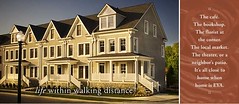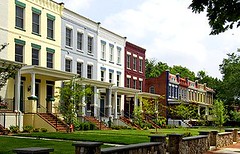Life within walking distance

Screen capture from the EYA website.
After shopping at the Florida Market yesterday (there is a piece about shopping at the Market in the current issue of the Hill Rag and DC North--my backside is depicted in one of the photos and I wonder if I am losing my hair...), I cheated because carrying a box of groceries on a bike for 4 miles is no fun, especially uphill and so I took the subway from the New York Avenue station to Takoma.
Within the subway car I noticed an advertising placard for the Arts District Hyattsville residential (with some retail) project on Route 1. It's a rowhouse project mostly that both Just up the Pike and I have written about before.
There are some issues (I don't think rowhouses are the right product for every piece of land), but I think it's fair to say that EYA does good work (and because of the real estate downturn these houses have come down in price quite significantly) when they build, and frankly they are one of the only production developers of new housing that manages to get the cornices right when they build new rowhousing in DC proper.

Note the cornices of the Bryan Square "new" (it's been a few years) rowhouses by EYA, in the section of houses on the left. On the right are "old"/historic porch front/S house/Wardman style rowhouses.
Maybe I hadn't noticed this before, or maybe it's a new slogan for EYA, but on the ad card they have this slogan (tagline) "Life within walking distance." From a copywriting standpoint, I was jealous because in four words they have succinctly encapsulated all the benefits of the best mixed use urban neighborhoods.
Of course, to live in a neighborhood fully replete with all the amenities you want and need to be able to reach by walking, you have to live in a more dense neighborhood like Adams Morgan or Dupont Circle. For the rest of us, our urban neighborhoods provide life within walking-bicycling-transit distance.
... Which brings us to the new report released by the Urban Land Institute Terwilliger Center for Workforce Housing – in partnership with the Center for Housing Policy and the Center for Neighborhood Technology – called Beltway Burden: The Combined Cost of Housing and Transportation in the Greater Washington, DC, Metropolitan Area.
According to the press release:
The report documents the challenges faced by working families in our area who are forced to “drive ‘till they qualify” for housing – that is, working families forced to incur higher transportation costs that eventually erode their housing cost savings. According to the report, an estimated 60% of households have either high housing cost burdens, high transportation cost burdens – or both.
This is something that I have understood to be true for quite some time, in terms of my own life and what I believe anecdotally, although I've never tried to study the question in the way that the ULI/CHP/CNT report has. The larger house/lot that you get farther out, while cheaper in terms of the initial cost to buy, is more costly when taking into account the time and cost of transportation to a household's major destinations such as work.
In some respects this is the basic foundation of the Location Efficient Mortgage, pioneered by the Center for Neighborhood Technology also. The LEM model works on the assumption that it is acceptable for a household to pay more than 1/3 of their income on a house when it is located by efficient transit, cancelling the need for the household to buy and maintain one or more cars. Since households by transit forgo a car, the $8,000 to $10,000/year that they would spend on a car can instead be directed to other needs, including house payments (but including $100-$200/month for transit).
Life within walking-bicycling-transit distance has other benefits as well. More time spent "doing" rather than time spent driving (or looking for parking).
This idea is almost captured graphically in one of the Livable Streets/Streetsblog Network widgets, like the one I use in the right sidebar, but reprinted here:

To be fully complete, it would need a "neighborhood" level, not just the city/landmarks/central business district level, something like how the logo of the Cool Cities program in Michigan has captured this idea.

Labels: bicycling, car culture and automobility, housing, transit, urban design/placemaking, urban vs. suburban, walking



0 Comments:
Post a Comment
<< Home